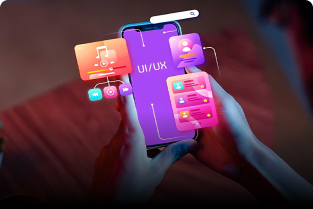The field of UI/UX design has always been at the forefront of innovation, adapting to technological advancements to create intuitive and engaging user experiences. With the rise of artificial intelligence (AI), the design landscape is undergoing a transformative shift. AI is not only streamlining design processes but also opening new possibilities for creativity and user engagement. In this blog, we will explore how AI is reshaping UI/UX design and what it means for designers and end-users alike.
1. Enhanced Personalization
AI-driven algorithms can analyze vast amounts of user data to create highly personalized experiences. By understanding user behavior, preferences, and patterns, AI enables designers to tailor interfaces that resonate with individual users. For example:
- Dynamic Content: Websites and apps can adapt their content based on user preferences in real-time.
- Smart Recommendations: E-commerce platforms can suggest products based on a user’s browsing and purchase history.
Personalization fosters stronger connections between users and digital platforms, enhancing satisfaction and engagement.
2. Automating Repetitive Tasks
Designers often spend significant time on repetitive tasks such as resizing images, formatting layouts, or generating style guides. AI-powered tools like Adobe Sensei and Figma’s AI plugins automate these processes, freeing up designers to focus on more strategic and creative aspects of their work.
Examples of AI Tools:
- Design Assistance: Tools like Canva’s Magic Resize and auto-layout features in Figma.
- Content Generation: AI can generate placeholder text, images, and even entire layouts based on initial inputs.
3. Smarter Prototyping and Testing
AI is revolutionizing the prototyping and testing phases of UI/UX design by enabling:
- Predictive Analytics: AI predicts user behavior, allowing designers to identify potential pain points before a product is launched.
- Automated Usability Testing: Tools like UsabilityHub and Lookback use AI to analyze user interactions and provide actionable insights.
- A/B Testing Optimization: AI accelerates the A/B testing process by analyzing results and suggesting improvements.
These advancements lead to faster iterations and more user-friendly designs.
4. Voice and Conversational Interfaces
The growing popularity of voice assistants like Alexa and Google Assistant is pushing designers to consider voice UI as part of the UX. AI plays a pivotal role in creating conversational interfaces that understand natural language and context.
Key Benefits:
- Accessibility: Voice interfaces make digital products more accessible to users with disabilities.
- Convenience: Users can interact with products hands-free, enhancing multitasking capabilities.
5. AI as a Creative Partner
AI tools are evolving from being mere assistants to creative collaborators. For instance:
- Generative Design: AI can suggest innovative design solutions by analyzing trends and user preferences.
- Mood Boards and Inspiration: Platforms like Pinterest use AI to curate personalized design inspirations.
While AI can’t replace human creativity, it can augment it by providing fresh ideas and speeding up brainstorming sessions.
6. Ethical Considerations in AI-Driven Design
As AI becomes integral to UI/UX design, ethical concerns arise, such as:
- Data Privacy: Designers must ensure that AI-driven personalization does not compromise user privacy.
- Bias in Algorithms: AI systems can perpetuate biases if not carefully monitored, leading to exclusionary designs.
- Transparency: Users should be aware of how their data is being used to shape their experience.
Addressing these concerns is crucial to building trust and ensuring inclusivity.
7. Future Challenges and Opportunities
While AI brings immense potential, it also poses challenges for designers, such as:
- Skill Evolution: Designers need to adapt by learning how to work alongside AI tools.
- Balancing Automation and Creativity: Striking the right balance between automation and human input is key to preserving the authenticity of design.
On the flip side, AI presents opportunities to:
- Explore uncharted creative territories.
- Deliver hyper-personalized and adaptive experiences.
- Make design processes more efficient and cost-effective.
Conclusion
AI is undeniably transforming the UI/UX design landscape, empowering designers to create more personalized, efficient, and innovative experiences. However, it is not a replacement for human creativity and intuition. Instead, AI acts as a powerful tool that complements and enhances the designer’s role. By embracing AI while addressing ethical concerns, designers can stay ahead of the curve and redefine the future of user experience.

